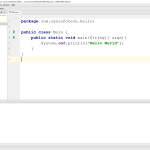Variables in Java are used to hold a certain value. They are declared as a variable type and are given a name. Then they are assigned a value which is then stored in a memory location.
Primitive Variables
There are eight different types of primitive variables in Java. They hold different data types and are allocated a pre-defined spaced in the memory.
| Data Type | Size | Minimum | Maximum | Default |
| boolean | 1 bit | false | ||
| char | 2 bytes | ‘\u0000\ | ||
| byte | 1 byte | -128 | 127 | 0 |
| short | 2 bytes | -32,768 | 32,768 | 0 |
| int | 4 bytes | -2,147,483,648 | 2,147,483,647 | 0 |
| long | 8 bytes | -9.22337E+18 | 9.22337E+18 | 0 |
| float | 4 bytes | 0.0f | ||
| double | 8 bytes | 0.0d |
You can set values as:
byte b = 1;
short s = 20;
int i = 20,000;
long l = 200L;
float f = 100.2f;
double d = 100.2d;
char c = ‘a’;
Note how double and float values are declared so that the compiler knows what type of data type they are. They are known as literals.
Non-Primitive or Reference Variables
These are data types that are pre-defined objects in java or are created by the user as an object. They must be defined and initiated to be used. For example: String, Array, enum, interface and user-defined class.
Using Strings
char[] characArray = {'K', 'a', 't', 'h', 'm', 'a', 'n', 'd', 'u'};
String placeName = new String(characArray);
System.out.println(placeName);
Output
Kathmandu
There’s a lot more that you can do with strings with helper classes and methods like concatenating, comparing etc.



No Comments